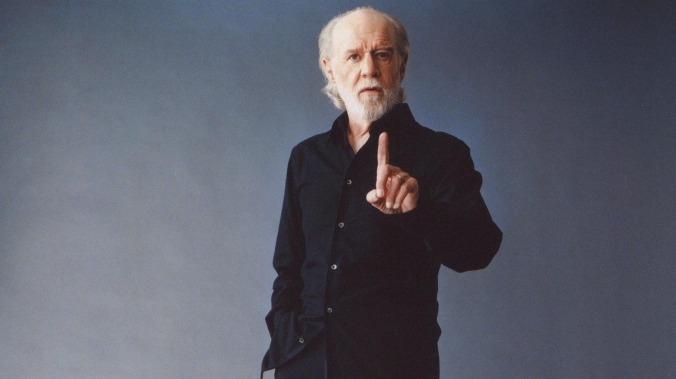George Carlin’s American Dream captures the many phases of an iconoclastic comedian
Judd Apatow and Michael Bonfiglio's two-part HBO documentary paints a personal portrait of an ever-evolving artist

As George Carlin’s American Dream winds down—and it takes a while to do that, as this two-part HBO doc is nearly four-hours long—we’re hit with a barrage of footage of American life, all of it having happened recently, well after the iconic comedian’s passing in 2008, and all of it soundtracked by Carlin’s articulate, motor-mouthed rants, the kind he was famous for in his black-longsleeve-and-slicked-back-gray-hair era. We see cops pepper spraying citizens’ faces during the George Floyd protests. We see people demanding abortion rights outside the Capitol, then later others storming said Capitol. We see Donald Trump holding that Bible. We see that one billionaire who took a penis-shaped rocket into space and that other one who wants to buy Twitter for some reason. We see overworked factory workers, fast-food employees, and nurses. We see a very cool looking Ted Cruz shooting a firearm wrapped in meat, then saying, all smiles and satisfaction, “mmm…machine-gun bacon.” We see another demonstration, this one outside a big-pharma office. And hey, isn’t that Matt Gaetz?
Is any of this subtle? No. It basically hammers you over the head with, “See George Carlin was right.” (This same point is driven home very early in the doc, with people tweeting out videos of his prophetic comedy routines, with exclamations along the lines of, “I can’t believe that George Carlin predicted [insert injustice here] 30 years ago!!”) But at this stage in his career, his truth-teller stage, if you will, Carlin wasn’t exactly a subtle comedian. And, you know what? He was right. That segment detailed above, that mashup of the shittiness of the here and now set against Carlin pontificating on the reasons for all of the shittiness in our country, is incredibly effective and stirring, the kind of montage that makes you mad and want to volunteer for worthy causes. (Props to directors Judd Apatow and Michael Bonfiglio and especially editor Joe Beshenkovsky for pulling it off.) “It’s called the American dream,” Carlin says, ending the segment, “because you have to be asleep to believe it.”
But that Carlin—the, to quote Howard Beale in Network, “angry prophet denouncing the hypocrisies of our times”—was only one of many. And the documentary does a nice job bookending with the most, let’s say, timely version of Carlin while still digging into the others: the suit-wearing half of a comedy team, the linguist, the hippie, the seven-dirty-words free-speech advocate (if you need a reminder, they’re “shit, piss, fuck, cunt, cocksucker, motherfucker, and tits”), the cocaine addict, the aforementioned elder statesman of sanity, and the “fuck everything” nihilist in his twilight years. (That list by no means captures all of Carlin’s stages or the intricacies of them.)
And then, as with Apatow’s lengthier HBO two-parter The Zen Diaries Of Garry Shandling, there is the comedian offstage: the Irish-Catholic kid growing up in Morningside Heights; the ninth-grade, joint-smoking dropout; the Danny Kaye wannabe; and—these are given the most screen time—the father and husband. (Coincidentally, it was Carlin who first encouraged Shandling to go for a career in comedy.) There are some revelatory moments captured here about Carlin’s family life, of his first-wife/publicist/all-around-supporter Brenda’s struggles with alcoholism, him being on the road constantly to avoid their house getting repossessed by the IRS, or lovelier, sun-soaked memories recounted by their daughter Kelly (a fantastic interviewee throughout), not to mention a tear-jerker or two.
When it comes to docs about artists, especially artists we admire, we have two pet peeves: 1) showing people reacting to their work on social media years later as if that validates it or makes it of-the-moment somehow, and 2) having too many talking heads, who often explain why someone is important as if we needed their explanations. On paper, American Dream seems to be guilty of both. There are those social-media praises we mentioned before. But they work swiftly in context, tidily showing that his thoughts on the powers-that-be are just as relevant now as then, that it’s all the same old story. There are plenty of talking heads, too—Patton Oswalt, W. Kamau Bell, Jon Stewart, Chris Rock, Sam Jay, Bill Burr, Steven Wright—but they never stray into redundant “You have to understand, Carlin was a genius” territory. The vast majority of them have something meaty and specific to say. A few of them, like Paul Reiser, even describe stranger-than-fiction personal encounters with Carlin. (That said, we could have lost one of the Jerry Seinfeld appearances.)
Over these nearly four hours, one thing that stands out is the man’s tenacity. He gets knocked down several times—because of drugs or, simply, aging out of being the hip envelope pusher—and gets up again, scrapping his way into a living by changing the game plan. (We can’t count the precise number of career do-overs the doc covers, but it’s a lot. Also, apologies for the “Tubthumping” nod.) In fact, he could be construed as a testament to that American bootstrap mythology, a takeaway that would probably make Carlin roll his eyes. And tell us to fuck off.